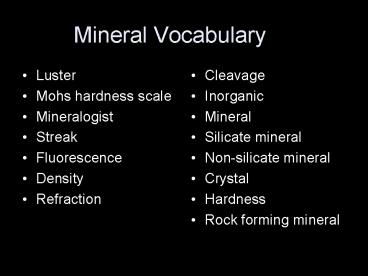Mineral Vocabulary - PowerPoint PPT Presentation
1 / 43
Title:
Mineral Vocabulary
Description:
Mineral Vocabulary Luster Mohs hardness scale Mineralogist Streak Fluorescence Density Refraction Cleavage Inorganic Mineral Silicate mineral Non-silicate mineral – PowerPoint PPT presentation
Number of Views:119
Avg rating:3.0/5.0
Title: Mineral Vocabulary
1
Mineral Vocabulary
- Luster
- Mohs hardness scale
- Mineralogist
- Streak
- Fluorescence
- Density
- Refraction
- Cleavage
- Inorganic
- Mineral
- Silicate mineral
- Non-silicate mineral
- Crystal
- Hardness
- Rock forming mineral
2
Minerals (Chpt.5)
- Identify the 4 characteristics used to classify
some rocks as minerals?
3
What is a Mineral?
- Basic materials of the Earths crust
- Natural, inorganic, crystalline solid.
- Inorganic not made up of living things or the
remains of living things. (non living, doesnt
contain carbon) - Organic substances come from plant and animal
sources (living)
4
4 Basic Characteristics of Minerals
- Composed of inorganic substances.
- Must occur naturally
- Must be solid in crystalline form, all minerals
have a characteristic structure. - Definite chemical composition.
- Arranged in a definite pattern, repeated over and
over.
5
Mineral statistics
- More than 4,000 known minerals
- 8 elements make up 98.5 of the crust
- Oxygen Silicon
- Aluminum Iron
- Calcium Sodium
- Potassium Magnesium
6
Classification of Minerals
- Minerals are classified into two main groups
based on chemical composition. - 1. Silcate Minerals
- 2. Non-Silicate Minerals
7
Composition of Minerals
- Silicate Minerals
- All contain silicon (Si) and O2 (Oxygen)
- All contain at least one other element
- All make-up 96 of the Earths crust
- 50 of the crust made of Feldspar Quartz
- Feldspar are the most common
8
Common Feldspar
Oligoclase
Albite
Orthoclase
Anorthite
9
Quartz (Silicon dioxide)
Smokey Quartz
Milky Quartz
Rose Quartz
Chalcedony
10
Phosphate Class
Apatite Turquoise
Anapaite
11
Other Silicates
Olivine Topaz
Leucite Biotite
12
- Non-silicate Minerals
- Does not contain Silicon (Si) or Oxygen (O2).
- Composed of 4 of the Earths crust
- Classified into 6 groups
13
Native Elements class
Gold Copper
- These are native metals
- They are simple in structure
- Have a metallic property
- These are found on the periodic table
Silver Lead
14
Oxides Class
- Large diversity of color to black
- Contain a large quantity of oxygen
- Metallic and nonmetallic minerals
15
Identifying Minerals
- Mineralogists conduct test w/ special equipment
to I.D. - Characteristics include
- Color Density
- Luster Fluorescence
- Streak Hardness
- Cleavage and Fracture Magnetism
- Refraction Crystal
16
Gemstone distribution
17
Month Birthstone
January Garnet
February Amethyst
March Aquamarine
April Diamond
May Emerald
June Pearl
July Ruby
August Peridot
September Sapphire
October Opal
November Topaz
December Turquoise
turquoise
18
Uses of Minerals
- art
- Jewelry
- Money
- Tools
- Fertilizer
- Quartz
- Gypsum
19
Other Uses
- Gemstones a hard, colorful mineral that has a
brilliant or glassy luster. - Once a gemstone is cut, its called a gem, ex
rubies, sapphires - Nonmetals elements that have dull surfaces and
are poor conductors of heat and electricity.
20
Fireworks
- The specific colors produced by fireworks are
produced by a specific mineral - Examples
- green barium
- reds strontium
- blues copper
- yellows sodium
- hemotite (iron) gold
21
(No Transcript)
22
Color
- Some have very bright colors,
ex sulfur bright yellow - Not a reliable I.D., because some have the same
color or weathering.
23
(No Transcript)
24
Luster
- Light reflected from the surface of a mineral
- Those minerals that reflect like polished metal
metallic luster.
25
(No Transcript)
26
(No Transcript)
27
Streak
- Color of the mineral in its powdered form
- Observe this by rubbing a mineral against an
unglazed piece of ceramic tile.
28
STREAK
29
Cleavage and Fracture
- Split easily along certain flat surfaces
- Its related to the types of bonds
- Those that do not have cleavage will break or
fracture.
30
Cleavage
31
Refraction
- The bending of light by minerals.
32
Density
- Ratio of mass to volume of a substance
- Minerals have various densities
33
Fluorescence
- The light from ultraviolet lamps reacts with the
chemicals of a mineral and causes the mineral to
glow
Fluorite under UV light
34
(No Transcript)
35
Hardness
- Ability of a mineral to resist scratching.
- Use Mohs hardness scale to determine hardness of
a mineral.
36
(No Transcript)
37
Examples of Mohs Scale
- your fingernail has a hardness of 2.5
- a penny has a hardness of about 3.5
- glass and a steel nail have nearly equal
hardnesses of 5.5 - a streak plate has a hardness of 6.5.
38
Minerals on Mohs Scale
- 1 Talc
- 2 Gypsum
- 3 Calcite
- 4 Fluorite
- 5 Apatite (fluorapatite)
- 6 Orthoclase
- 7 Quartz
- 8 Topaz
- 9 Corundum
- 10 Diamond
39
Magnetism
- Some minerals have a positive or negative
attraction
40
Crystal
- Specific crystal shape
- Certain minerals have the same crystal shape, due
to the chemistry of the mineral
41
(No Transcript)
42
Open-Notes Quiz Minerals
- What are the four characteristics a rock must
have to be classified as a mineral? - What is the difference between the silicate group
and the non-silicate group. Give an example of
each. - List ten characteristics mineralogists use to
identify minerals.
43
(No Transcript)































